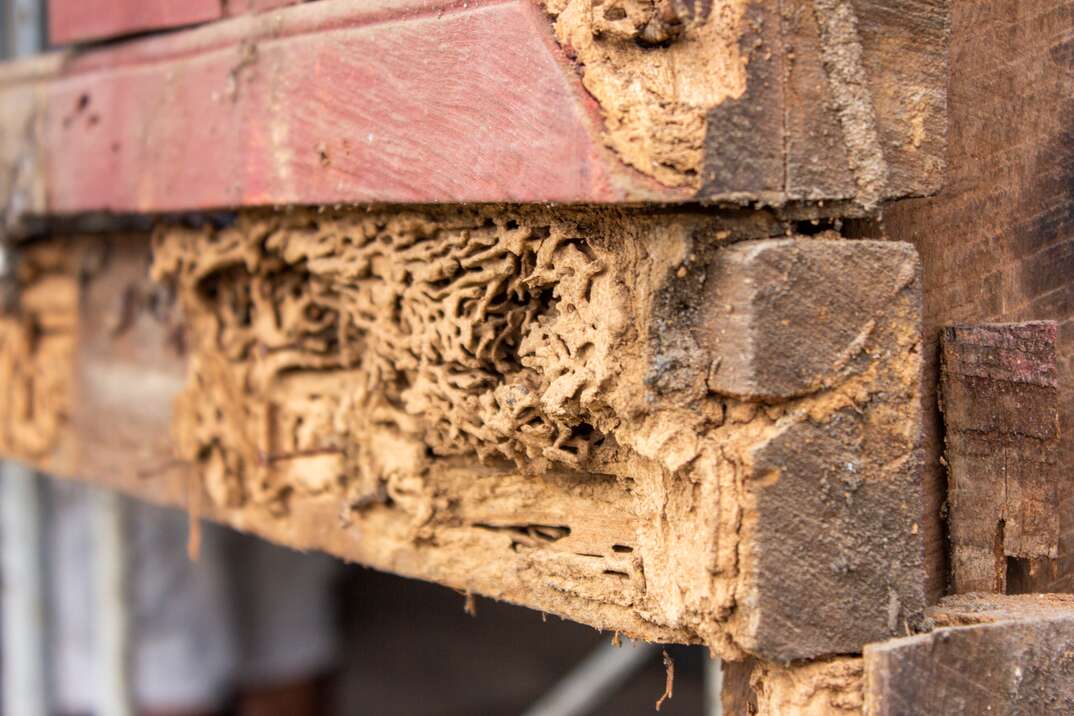10 Ways to Prevent Termites

Termites are little experts in chomping down wood. Out in nature, they help clear the forest floors. In your house, though, they're a dangerous pest.
To keep these unwanted guests out, the rules are simple: Cut off their access to food and water and don’t allow them any springboards into your home. This guide covers the steps you can take to prevent termites from getting in.
What Causes a Termite Infestation?
Moisture
Standing water is an attractive invitation to those pesky termites. Leaky pipes, bad drainage and poor ventilation can all cause a termite infestation. Outside, improper drainage around the structure’s foundation can cause problems.
Wood That's in Contact With Soil
Subterranean termites need to move through wood and soil. Any wood touching the soil outside your house leaves it susceptible to infestation. Stacks of wood left close to the house can also leave it vulnerable.
Cracks in Building Exteriors
Cracks, fissures and gaps in the walls are another way for termites to get inside. Subterranean termites can build mud tubes through these to move into your home. Gaps near doors and windows can be an opportunity for swarmer species to get inside.
Geography
If you live in a humid area, you'll have a higher chance of a termite problem. (See “moisture” above.) In these areas, it's worth taking extra caution when it comes to termite prevention. That said, termites are present in every state except Alaska, so these checks are always important.
1. Minimize Moisture
The first step in termite prevention is to rid any excess moisture in the house. If you spot any plumbing issues, even small drips from faucets or pipes, get them repaired immediately. Also, make sure there's no water pooling anywhere on the roof or collecting in the garden near the house.
2. Maintain Strong Ventilation
Fix poor ventilation, especially in bathrooms and kitchens, as the condensation will encourage termites. Clean and repair faulty air conditioning units or buy a dehumidifier for the space.
3. Keep Wood Away From Soil
If any soil touches woodwork, it needs to be fixed straight away as this is an easy way for termites to gain access to your home. As a rule, there should be a minimum of 18 inches between soil and wood. You may need to pull soil back from the house’s foundation, cut back any wooden structures touching the ground or lay down a gravel bed over the soil.
4. Store Wood Away From the House
Debris around the house can be especially useful to termites. Debris of various types can act as a bypass to soil — even soil treated with termiticide. Move firewood, cardboard and newspapers at least 20 feet away from the house. If this isn’t possible, raise wood off the ground with a concrete slab or metal frame.
5. Seal Cracks
Seal any small cracks in your home to prevent termites from getting in the house. An easy way to do this is by applying a fresh coat of paint, which will seal up any gaps.
6. Inspect Crawl Spaces
Make sure crawl spaces are well ventilated. A vent of 1 square foot should be present for every 150 square feet of crawl space area. Clear these vents of debris, such as leaves and twigs, regularly to keep them effective.
7. Check Outdoor Plants
Dense vegetation growing outside your home can create a bridge for termites. Where practical, remove dead roots or stumps near the home. Trim back hedges and make sure there are at least 12 inches between shrubbery and the exterior walls of your home.
8. Termite Treatments
Protect wood with repellent DIY termite treatment. Use this on decking, fences, sheds and similar areas to stop termites from getting near them. For newer structures, you can buy pre-treated wood. This is a good choice in humid climates more prone to termite infestation.
9. Get Regular Inspections
To make sure there is nothing you have overlooked, and to get specialist advice, get a pest check from a professional annually. The cost of an inspection will be well worth it if it saves your home from an infestation.
10. Look Out for Signs of Termites
The quicker you spot a termite infestation, the more damage you can prevent to your home. Look out for clicking sounds from the walls, difficulty opening windows and doors, termite droppings (small, black, powdery marks), hollow-sounding timber and paint damage. If you see these signs, call a termite pest control expert immediately.
Elocal Editorial Content is for educational and entertainment purposes only. Editorial Content should not be used as a substitute for advice from a licensed professional in your state reviewing your issue. Systems, equipment, issues and circumstances vary. Follow the manufacturer's safety precautions. The opinions, beliefs and viewpoints expressed by the eLocal Editorial Team and other third-party content providers do not necessarily reflect the opinions, beliefs and viewpoints of eLocal or its affiliate companies. Use of the Blog is subject to the
Website Terms and Conditions.The eLocal Editorial Team operates independently of eLocal USA's marketing and sales decisions.



